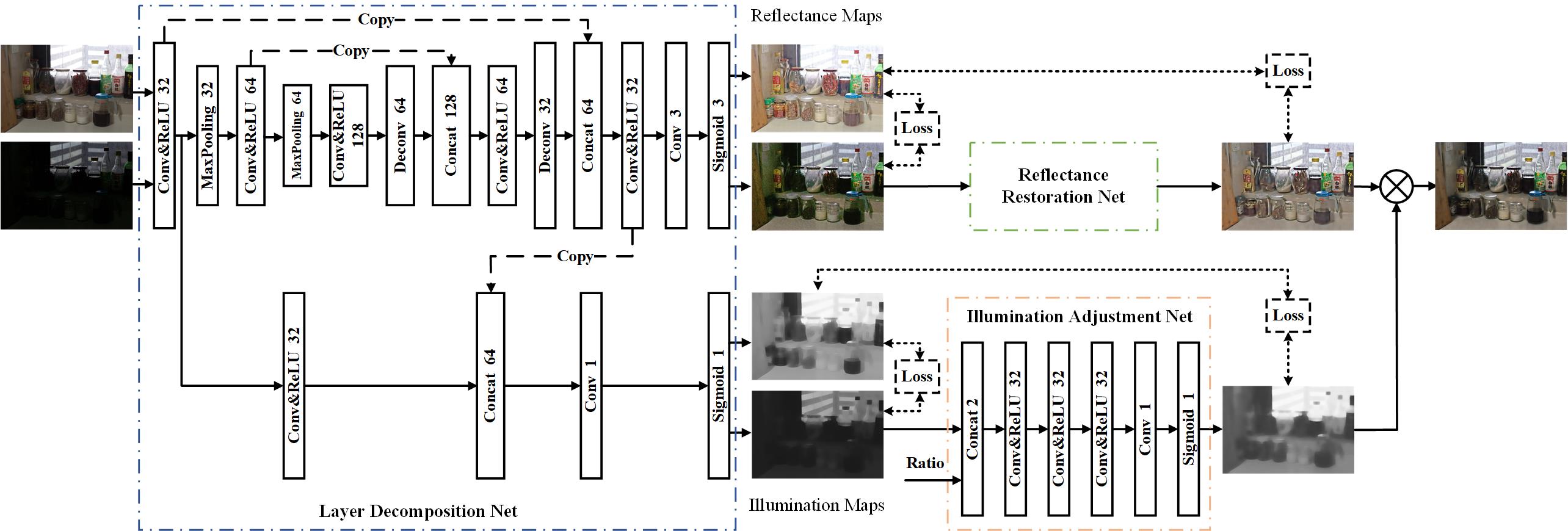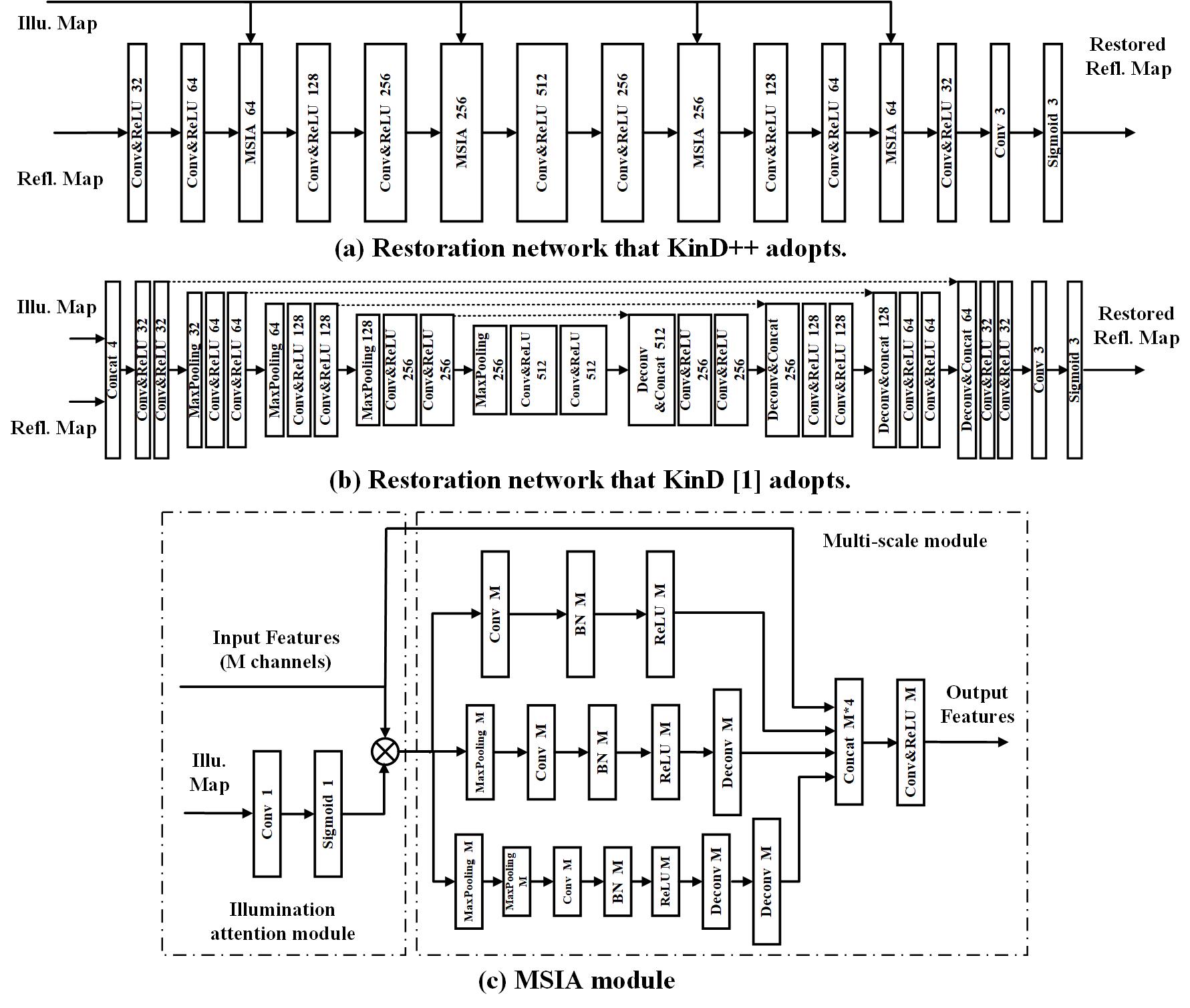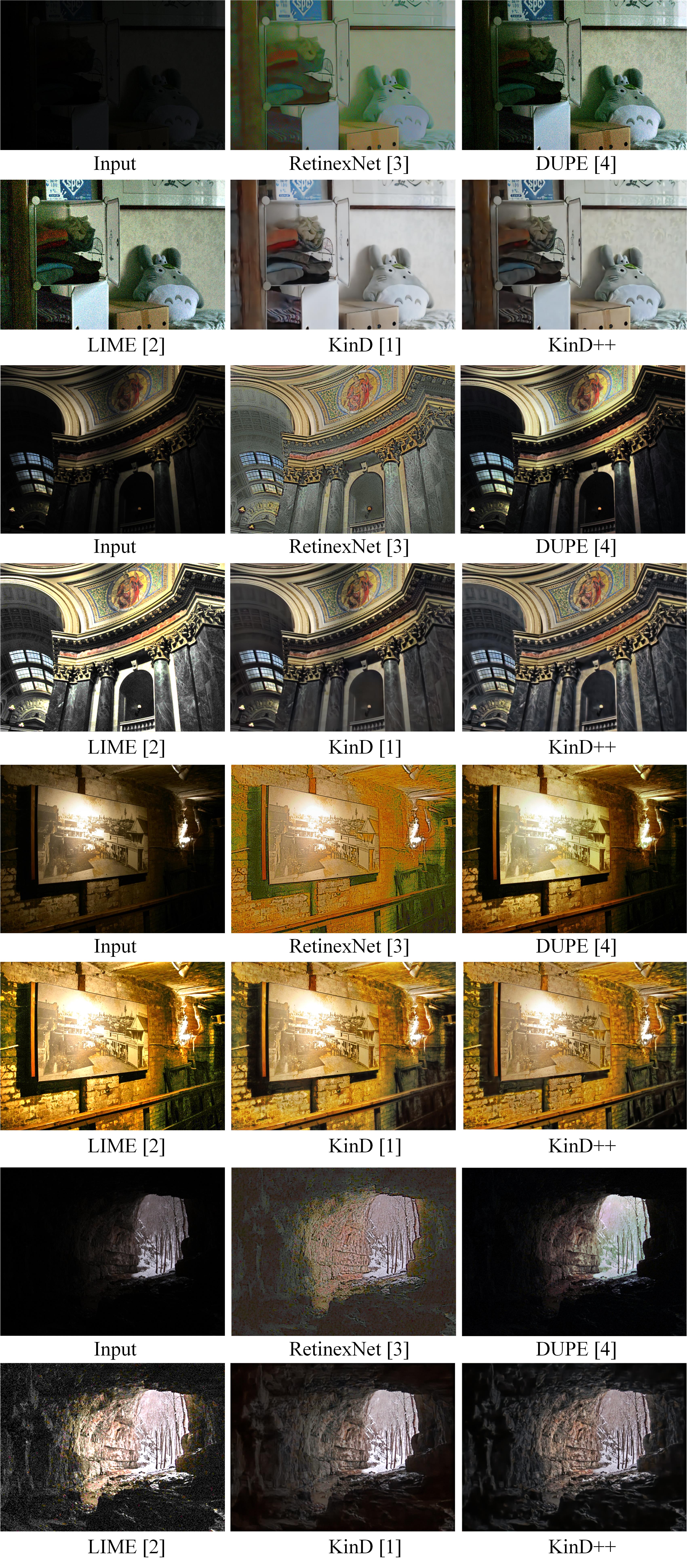This is a Tensorflow implementation of KinD++. (For the paper: Beyond Brightening Low-light Images)
Zhang, Y., Guo, X., Ma, J. et al. Beyond Brightening Low-light Images. IJCV, (2021).
We propose a novel multi-scale illumination attention module (MSIA), which can alleviate visual defects (e.g. non-uniform spots and over-smoothing) left in KinD.
The KinD net was proposed in the following Paper.
Kindling the Darkness: a Practical Low-light Image Enhancer. In ACM MM 2019
Yonghua Zhang, Jiawan Zhang, Xiaojie Guo
To better adapt to TensorFlow 2.0, we modified our code.Now you can run this code directly using TensorFlow 2.0.
- Python
- Tensorflow >= 2.0
- numpy, PIL
Please put test images into 'test_images' folder and download the pre-trained checkpoints from google drive or BaiduNetDisk, then just run
python evaluate.pyThe test datasets (e.g. DICM, LIME, MEF and NPE) can be downloaded from google drive. Our enhancement results of these datasets can be downloaded from google drive.
The original LOLdataset can be downloaded from here. We rearrange the original LOLdataset and add several pairs all-zero images and 260 pairs synthetic images to improve the decomposition results and restoration results. The training dataset can be downloaded from google drive. For training, just run
python decomposition_net_train.py
python illumination_adjustment_net_train.py
python reflectance_restoration_net_train.pyYou can also evaluate on the LOLdataset, just run
python evaluate_LOLdataset.py- Single-scale Retinex (SSR) [5]
- Multi-scale Retinex (MSR) [6]
- Naturalness preserved enhancement (NPE) [7]
- Fusion-based enhancing method (MEF) [8]
- LIME [2]
- SRIE [9]
- Dong [10]
- BIMEF [11]
The codes of above-mentioned methods can be found from here. - CRM [12] (code)
Non-reference metric NIQE is adopted for quantitative comparison. The original code for computing NIQE is here. To improve the robustness, we follow the author's code and retrain the model parameters by extending 100 high-resolution natural images from PIRM dataset. Put the original 125 images and additional 100 images (dir: PIRM_dataset\Validation\Original) into one folder 'data', then run
[mu_prisparam cov_prisparam] = estimatemodelparam('data',96,96,0,0,0.75);After retrained, the file 'modelparameters_new.mat' will be generated. We use this model to evaluate all results.
[1] Y. Zhang, J. Zhang, and X. Guo, “Kindling the darkness: A practical low-light image enhancer,” in ACM MM, 2019, pp. 1632–1640.
[2] X. Guo, Y. Li, and H. Ling, “Lime: Low-light image enhancement via illumination map estimation,” IEEE TIP, vol. 26, no. 2, pp. 982–993, 2017.
[3] C. Wei, W. Wang, W. Yang, and J. Liu, “Deep retinex decomposition for low-light enhancement,” in BMVC, 2018.
[4] R. Wang, Q. Zhang, C.-W. Fu, X. Shen, W.-S. Zheng, and J. Jia, “Underexposed photo enhancement using deep illumination estimation,” in CVPR, 2019, pp. 6849–6857.
[5] D. J. Jobson, Z. Rahman, and G. A. Woodell, “Properties and performance of a center/surround retinex,” IEEE TIP, vol. 6, no. 3, pp. 451–462, 1997.
[6] D. J. Jobson, Z. Rahman, and G. A. Woodell, “A multiscale retinex for bridging the gap between color images and the human observation of scenes,” IEEE TIP, vol. 6, no. 7, pp. 965–976, 2002.
[7] S. Wang, J. Zheng, H. Hu, and B. Li, “Naturalness preserved enhancement algorithm for non-uniform illumination images,” IEEE TIP, vol. 22, no. 9, pp. 3538–3548, 2013.
[8] X. Fu, D. Zeng, H. Yue, Y. Liao, X. Ding, and J. Paisley, “A fusion-based enhancing method for weakly illuminated images,” Signal Processing, vol. 129, pp. 82–96, 2016.
[9] X. Fu, D. Zeng, Y. Huang, X. Zhang, and X. Ding, “A weighted variational model for simultaneous reflectance and illumination estimation,” in CVPR, 2016, pp. 2782–2790.
[10] X. Dong, Y. Pang, and J. Wen, “Fast efficient algorithm for enhancement of low lighting video,” in ICME, 2011, pp. 1–6.
[11] Z. Ying, L. Ge, and W. Gao, “A bio-inspired multi-exposure fusion framework for low-light image enhancement,” arXiv: 1711.00591, 2017.
[12] Z. Ying, L. Ge, Y. Ren, R. Wang, and W. Wang, “A new low-light image enhancement algorithm using camera response model,” in ICCVW, 2018, pp. 3015–3022.
[13] W. Wang, W. Chen, W. Yang, and J. Liu, “Gladnet: Low-light enhancement network with global awareness,” in FG, 2018.


